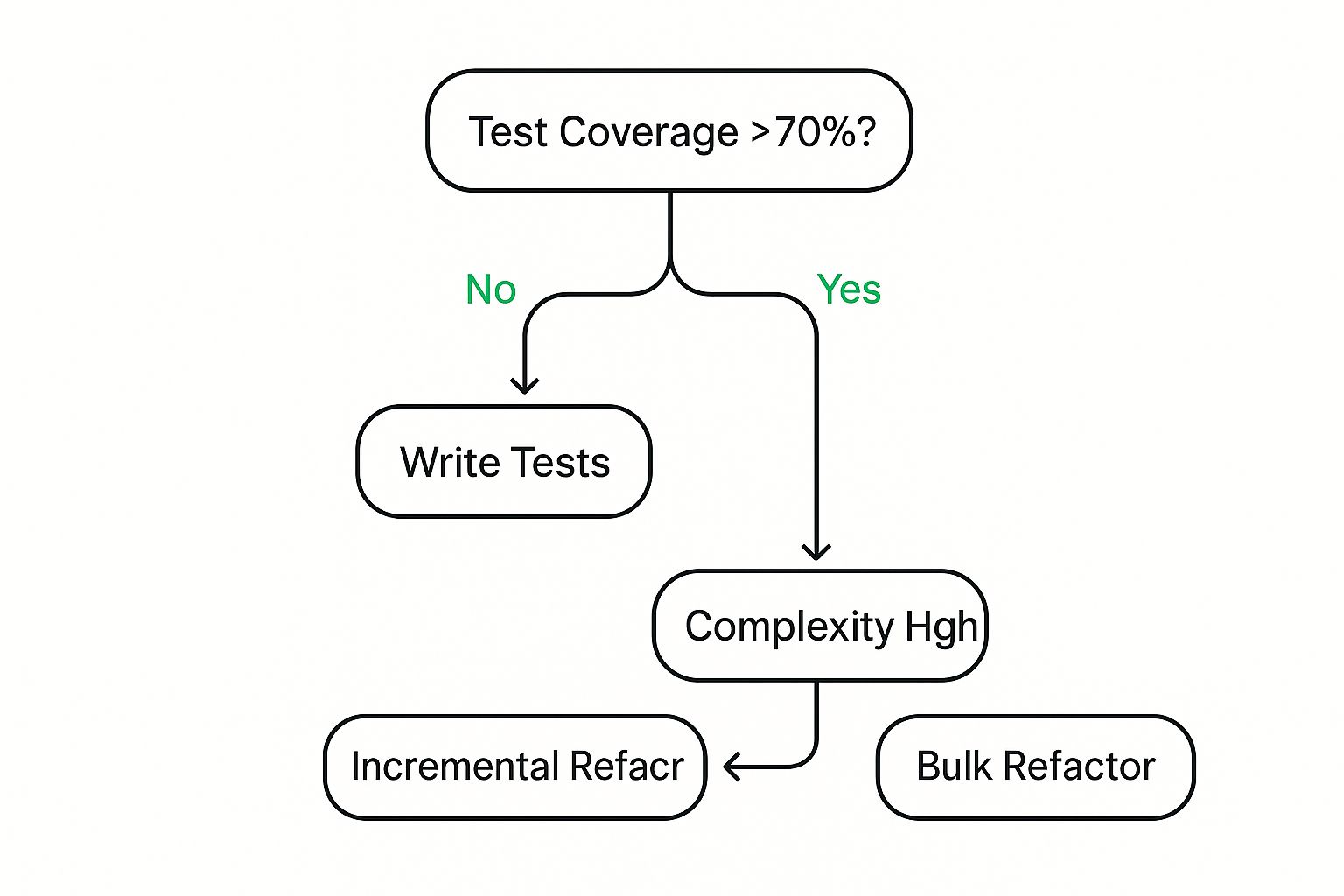Master legacy code refactoring with proven strategies from developers who've transformed countless codebases. Get practical tips that actually work.

Before diving headfirst into refactoring, take a moment to truly grasp the legacy code you’re about to tackle. Just like a careful archaeologist wouldn’t bulldoze an ancient site, you need a measured approach – think incident management for your code. You wouldn’t just start hacking away, would you? It’s about understanding the history and context, not just the surface level.
This initial phase is all about discovery. Why was the code written this way? What were the original developers thinking? What limitations were they working with? Sometimes, code that looks messy actually has a hidden purpose. I remember once wrestling with a particularly convoluted piece of code, only to discover it was a brilliant performance optimization for a resource-constrained system.
Often, legacy code lacks decent documentation. So, you’ll need to put on your detective hat and look for clues. Think commit messages, old bug reports, or even (if you’re lucky) chatting with the original developers. It’s time-consuming, but trust me, it’s better than accidentally breaking something critical. This lack of documentation contributes to the challenges of refactoring, often making initial efforts feel less than cost-effective. I once saw a developer break over 2,700 tests after a refactoring attempt, all thanks to dependencies on persisted data between tests.
Refactoring doesn’t always offer instant gratification. The Pareto principle (80/20 rule) often applies – 80% of the benefit comes from 20% of the work. Focus on the changes that make the biggest impact. Reducing technical debt through refactoring is a long-term investment. It might not feel like a win right away, but it will save you headaches (and potentially a lot of money) down the road. For more on knowing when to stop refactoring, check out this helpful blog post: When Should You Stop Refactoring Legacy Code?.
Before you start changing anything, you need to find the critical components – the parts of the system that are absolutely essential. These are your load-bearing walls, the central nervous system of your codebase. Changing them carelessly could bring the whole thing crashing down.
How do you identify these vital areas? One telltale sign is frequently modified code. This often indicates core functionality or areas prone to bugs. Another clue is complex code with a lot of dependencies. This is the fragile stuff; changes here can ripple through the system like a seismic wave.
To help you assess your legacy code, let’s look at this comparison matrix:
Legacy Code Assessment Matrix: A comparison of different approaches to evaluating legacy codebases based on complexity, risk, and business impact
This table offers a quick overview of various assessment methods, their associated time investment and risk, and the potential business value they provide. Choosing the right approach depends on your specific needs and constraints.
By understanding your legacy code’s nuances – its history, its quirks, its crucial components – you’re setting yourself up for a much smoother ride. Remember, you’re not just changing code; you’re working with a living, breathing system.

This screenshot shows GitHub Actions, a handy tool for automating all sorts of workflows, especially testing. Hooking up your tests to a CI/CD pipeline, like this, gives you constant feedback as you refactor. This feedback loop is key to catching those pesky regressions early and often.
Refactoring legacy code without tests is just asking for trouble. It’s like trying to change a tire while the car is still rolling. Possible? Maybe. A good idea? Definitely not. That’s why building a solid safety net of tests is the most important first step in any legacy code refactoring project. Consider it your insurance policy against things going sideways.
First up: characterization tests. These tests aren’t about how the code should work; they’re about how it actually works, warts and all. They’re there to document the existing functionality, even if it makes no sense.
For example, let’s say you find a function that calculates taxes but also, for some reason, updates the user’s address. A characterization test captures both of these behaviors. It might feel weird, but it’s crucial. Remember, the goal is to refactor without changing how things currently work, and these tests will shout if you accidentally break something.
Legacy systems are notorious for code that’s seemingly impossible to test. Global state, hidden dependencies, and functions that do five different things—it can feel like the wild west. So, how do you wrangle this code into a testable state?
One way is to create seams. These are points where you can inject test doubles or mocks to isolate the code you’re testing. This can be tricky, but often it’s the only way to untangle dependencies and make testing possible. Another tactic is to do some light refactoring to improve testability before you start the main refactoring work. This might involve extracting smaller functions, introducing interfaces, or eliminating global state.
For an extra layer of protection, look into canary deployments and feature flags. Canary deployments let you roll out your refactored code to a small group of users first. This helps catch unexpected problems in a real-world setting but on a smaller scale.
Feature flags offer even more control. They let you switch features on and off in production without deploying new code. This is incredibly helpful for testing refactored code in the wild and quickly reverting if something goes wrong. Think of them as your emergency brake.
Building a safety net isn’t just about writing tests; it’s about building confidence. With solid tests and smart deployment strategies, you can refactor legacy code knowing you can catch and fix problems quickly. This reduces the risk of production outages and sets you up for success. This approach, similar to the Strangler Fig Application pattern, allows you to gradually modernize your codebase, replacing old parts with new while keeping everything running smoothly. It’s all about sleeping well at night knowing your code is working as expected.

Picture this: your dev team is wrestling with a massive, ancient codebase, something straight out of the digital dark ages. Meanwhile, your competitors are zipping ahead, launching new features built on sleek, modern architectures. Sound familiar? This is the daily grind for many businesses dealing with legacy code. Let’s talk about why legacy code refactoring is no longer optional, but absolutely essential for staying in the game. Curious about refactoring itself? Check out this post: What is Code Refactoring?
Forget the technical jargon for a second. Let’s talk real-world impact. I’ve seen firsthand how refactoring can turbocharge development speed. I once worked with a company that, after a major refactoring project, saw a 30% decrease in the time it took to develop new features. That translated directly into faster releases and a real boost to their revenue. They were outpacing their competition, a huge advantage in today’s market.
So, how did they sell the initial investment in refactoring? They focused on the return on investment (ROI). They compared the cost of the project with the projected savings from lower maintenance costs, quicker development cycles, and fewer bugs. That ROI calculation was their golden ticket to getting leadership on board.
Developers often find it difficult to explain the importance of refactoring to non-technical folks. The trick is to translate those technical headaches into something executives understand – cold, hard cash. For instance, instead of saying “this code is a nightmare to maintain,” try something like, “Fixing bugs in this legacy code takes us twice as long, which is costing us X dollars every year.”
This change in approach makes the benefits of refactoring crystal clear. It’s not about making life easier for developers; it’s about boosting the company’s profits.
Refactoring isn’t just about fixing old code; it’s about opening up new possibilities. Think modern deployments, cloud migration, and integrating AI. These become much harder with a clunky, outdated codebase. Legacy code refactoring has become increasingly important as technology continues to advance and users expect more and more from software. Gartner projects that by 2025, 95% of new digital workloads will be cloud-native, highlighting the urgent need to modernize legacy systems. Discover more insights. This shift is driven by the need for better performance and scalability, two things often held back by legacy code.
Refactoring lays a solid foundation for adapting to new tech and staying ahead of the game. While you’re struggling with your outdated code, your competitors might already be using these advancements to their advantage. A crucial step in creating a safety net for your refactoring efforts is having solid backups. A tool like this can help: WordPress backup plugin. Investing in refactoring isn’t just about fixing the past; it’s an investment in your future. You’re building a system that’s ready for anything, ensuring you remain competitive in the ever-changing world of tech.

This infographic gives you a simple way to decide between incremental refactoring and tackling it all at once. Notice how important testing is. If your tests aren’t up to par, focus on writing them first. Then, look at how complex your code is. If it’s a tangled mess, a careful, incremental approach is best. If it’s relatively straightforward, you might be able to refactor larger chunks.
Refactoring legacy code doesn’t mean you need to fix every single line. Trying to do that can lead to burnout and frustrated stakeholders. What you need is a strategy. Focus on the areas that give you the biggest return on your effort.
Where should you start? Look for code that everyone on the team touches frequently, like utility classes or shared libraries. These are perfect candidates. Even small improvements here can make a big difference for everyone. Another good target? That giant “God object” that everyone’s afraid to touch. Breaking it down into smaller, more manageable pieces can simplify development and testing significantly.
Here’s a real-world example: I once worked on a project where a single utility class handled date formatting, data validation, and database connections. Talk about a multi-tasking mess! Refactoring that one class made the entire codebase easier to read and maintain.
Refactoring can be tricky. You start with one small change and suddenly, you’re rewriting the whole system. That’s scope creep, and it’s a common issue. The solution? Set clear boundaries from the start. Just as important is setting realistic expectations with stakeholders. Make sure they understand that refactoring isn’t a quick fix, especially for complex systems. It’s a process.
One way to manage this is by breaking the project into smaller pieces. This shows progress and builds confidence. Keep stakeholders in the loop with regular updates, even if the changes aren’t user-facing. This helps maintain their support throughout the process.
Refactoring might not add any shiny new features, but it’s crucial to show its value. How? Track things like reduced bug counts, improved code coverage, and faster development times. These metrics demonstrate the positive impact of refactoring, even if it’s all happening behind the scenes.
To help you prioritize your refactoring tasks, take a look at this table:
Refactoring Priority Framework A decision matrix for prioritizing refactoring efforts based on business value, technical complexity, and risk factors.
This table helps you analyze which areas need immediate attention versus those that can be addressed later. Notice how areas with high business impact, high technical complexity, and high risk receive the highest priority scores.
Remember, refactoring is an investment. It’s like choosing the right Git branching strategy—it sets you up for the long haul. By focusing on high-impact areas, managing expectations, and clearly communicating progress, you can make your refactoring efforts both effective and sustainable. This creates a healthier, more maintainable system that can adapt to future needs.
So, you’ve prepped, got your tests in place, and pinpointed the messy parts of your code. Now for the fun part: actually refactoring! It’s like trading in a clunky old car for a sleek, new model. Both get you where you need to go, but the new one is a much smoother ride.
We’ve all seen it: the thousand-line method. That behemoth of a function that handles half the application logic and makes you want to run for the hills. The Extract Method refactoring pattern is your savior here. Find sections of code that perform a single task, pull them out into their own well-named methods, and watch that monster shrink down to size.
For example, I once wrestled with a massive method that handled user authentication, processed payments, and updated inventory. By extracting authenticateUser(), processPayment(), and updateInventory(), the code became dramatically easier to understand and maintain. It felt like finally organizing a chaotic closet – a bit of work upfront, but so worth it in the end.
Another common legacy code problem: the ever-expanding switch statement. It starts small, but grows and grows like a vine, becoming a tangled mess. Here, the Replace Conditional with Polymorphism pattern is your go-to solution. Create an interface or abstract class to represent the different cases in your switch, and then implement specific classes for each one. This transforms a messy switch into a clean, object-oriented design.
Code duplication is insidious. Copy-pasting seems so easy in the moment, but it creates a maintenance nightmare down the line. The Don’t Repeat Yourself (DRY) principle is key. Find duplicated code blocks and extract them into reusable functions or classes. A word of caution, though: avoid premature abstraction. Only abstract when you see a clear reuse pattern, not just because you think you might reuse it later. This prevents you from building overly complex abstractions that no one understands. Check out Code Refactoring Best Practices for more tips on this.
Naming is crucial for clean code. Legacy systems are often littered with cryptic variable names like x, y, and temp, leaving you wondering what they actually represent. Take the time to give these variables descriptive, meaningful names. It’s a small change with a big impact on readability. And speaking of impact, refactoring isn’t just about making code pretty; it has real business benefits, like reducing downtime and lowering long-term costs. Legacy Code Refactoring: A Guide for 2024 delves deeper into the financial advantages.
These are just a few practical refactoring techniques. The key is to use them wisely, understanding the trade-offs of each. Overusing polymorphism can add unnecessary complexity, while premature abstraction can make code harder to grasp. The art of refactoring lies in knowing which technique to apply, and when to simply leave well enough alone.
Let’s face it, refactoring legacy code manually can feel like an uphill battle. It’s slow, tedious, and prone to errors. Thankfully, we’ve got some powerful tools at our disposal that can transform this often-dreaded task into something far more efficient and even, dare I say, enjoyable.
Think of it like this: you wouldn’t perform surgery with a butter knife, would you? So why wrestle with outdated code when you can have the precision of a laser scalpel?
This screenshot shows IntelliJ IDEA, a powerful IDE packed with refactoring features. Look at those automated suggestions and safe rename operations – having this kind of power directly in your development environment makes a world of difference in minimizing errors and streamlining the entire process.
Modern IDEs like IntelliJ IDEA, Eclipse, and Visual Studio Code are your first line of defense. They offer built-in refactoring tools that go way beyond simple renaming. Think extracting methods, introducing interfaces, and even identifying duplicated code – all automatically. Personally, I’ve saved countless hours using these features, especially when tackling large codebases where manual changes would be a nightmare.
These IDEs are your trusted companions for efficiently and safely carrying out those everyday refactoring tasks. Imagine trying to rename a variable used in hundreds of files manually – yikes!
Static analysis tools, such as SonarQube and PMD, are like having a dedicated code detective on your team. They tirelessly scan your code, looking for potential refactoring hotspots. Think complex methods, unused variables, and those pesky “code smells.” These tools are invaluable for uncovering hidden issues that might slip through even the most rigorous manual code reviews. Plus, they offer objective metrics on code quality, allowing you to track your refactoring progress.
Baking refactoring into your Continuous Integration (CI) pipeline is like having a safety net. Every code change gets automatically tested, meaning any breaking changes are caught early – before they wreak havoc in production. This gives you the confidence to refactor fearlessly, knowing you have automated checks in place. Tools like Jenkins, GitLab CI, and GitHub Actions make automating your tests and builds a breeze. Catching regressions early prevents those late-night fire drills.
A solid automated testing framework is essential. With comprehensive tests, you can make changes with confidence, knowing any unintended consequences will be flagged automatically. Tools like JUnit, pytest, and Mocha simplify writing and running tests. They give you the freedom to refactor without the constant worry of breaking something.
The last piece of the puzzle? Automating your deployments. Tools like Ansible, Chef, and Puppet take the human error out of deploying your refactored code. Your changes reach production quickly and reliably. This lets you ship improvements confidently, knowing the process is smooth and predictable. This continuous delivery approach, coupled with the safety net of automated testing, empowers your team to make frequent, incremental improvements to that legacy codebase.
AI-powered tools are starting to make a real impact in the world of legacy code refactoring. While they’re not a silver bullet, they can automate certain tasks, such as spotting potential code smells and suggesting refactoring patterns. It’s important to remember these tools are still developing and should be used to augment – not replace – human judgment. They can analyze vast amounts of code, highlighting potential issues a human might miss, but careful review and validation remain critical. These tools represent an exciting future for legacy code refactoring, promising even greater efficiency and code quality.
So, you’ve refactored a chunk of that legacy code. Fantastic! But let’s be real, the heavy lifting isn’t just about a one-time fix. It’s about cultivating a development environment where code quality steadily improves and technical debt doesn’t take over. Think of it as building a habit where refactoring is as natural as breathing.
Code reviews are your frontline defense against future legacy code headaches. But they can easily turn into pointless box-ticking exercises. The real magic happens with meaningful discussions. Don’t just hunt for typos; dive into design choices, potential performance bottlenecks, and areas ripe for simplification. Explore the available Tools to streamline your refactoring efforts. From my experience, peer reviews where developers explain their reasoning behind certain code choices can unearth valuable insights and catch potential problems before they blow up.
Sometimes, just talking it through helps someone realize a better approach!
Coding standards are awesome… in theory. They only work if the team actually uses them. The secret sauce? Create standards that are practical and enforceable. Avoid ridiculously strict rules that kill creativity. Instead, focus on core principles: readability, maintainability, and testability. Hook your coding standards into your CI/CD pipeline with automated linters and style checkers. This makes following the rules automatic and takes the burden off individual developers.
Documentation often gets the short end of the stick in fast-paced development. But trust me, good documentation is crucial for sustainable refactoring. It helps future developers (including your future self) understand the “why” behind the code. Try tools that generate documentation straight from the code. This keeps documentation current and accurate with minimal effort. Think of it as a time capsule of understanding!
The struggle is real: shipping new features vs. maintaining code quality. The key is finding a sustainable balance. Carve out specific time for refactoring in each sprint. Even small, incremental improvements add up over time. This prevents technical debt from becoming a monster you can’t control.
You need to show the impact of your refactoring efforts. Track key metrics like fewer bugs, improved performance, and faster development cycles. These concrete results demonstrate the positive impact of refactoring and justify the time investment to stakeholders.
Making refactoring sustainable is about building a culture of continuous improvement. It’s about shared responsibility for code quality, weaving it into every part of development. By focusing on these strategies, you create an environment where clean, maintainable code thrives.